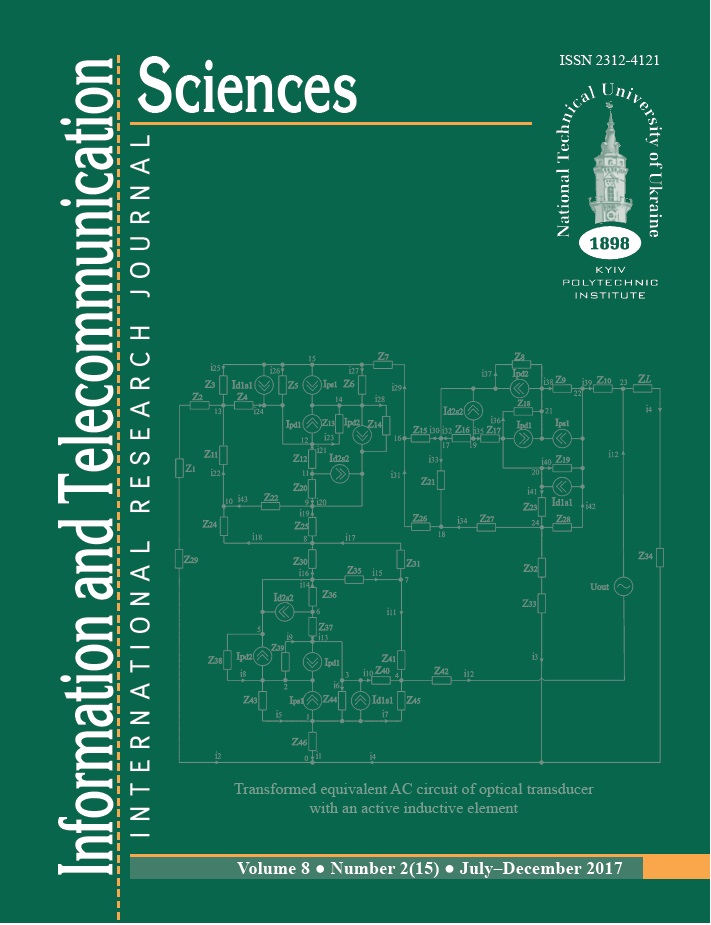SCOPE EXTENSION IN A CONVERGED NETWORK
DOI:
https://doi.org/10.20535/2411-2976.22017.11-17Keywords:
networks interoperability, QoS, real-time applicationsAbstract
Background. Unified IP-based provisioning of communication services often faces the problem of QoS guarantees during the real-time application traffic transmission. The packet loss and random time delays in statistically multiplexed data flow apparently make a lot of trouble during remote audio/video conversation or machine-to-machine interaction in real time mode. Known IP-based approaches in telecom network engineering can’t meet the highly increasing operator demands and consumer requirements to QoS-aware services; this hinders the Internet and telephone networks convergence with respect to quality of service provision. Therefore, more research needed to effectively address these problems.
Objective. The aim of the paper is the interoperability scope extension in a converged telecom network to provide realtime data transfer with quality of service support.
Methods. The current state of “Internet+telephone network” along with the synthesis of an advanced interface for a heterogeneous network is analyzed.
Results. Basic principles introduced to extend the autonomous network interoperability. A novel mechanism of conveyor transporting modules originated for a converged network to benefit packet and circuit switching unification.
Conclusions. Traditional telecoms and Internet service providers permanently compete for IT market niches having their pros and cons, and vast IP-applications merged on the market. Therefore, no urgent successor-protocol reasonable in a short term. On this agenda, an alternative algorithm proposed for dynamic packet data allocation in a unified network-tonetwork link, which extends the interoperability scope in a converged network. The Gigabit Ethernet linkage outlined based on proposed algorithm.
Keywords: networks interoperability; QoS; real-time applications.
References
General overview of NGN // ITU-T Recommendation Y.2001 (12/2004). – 2004.
Generalized Multi-Protocol Label Switching (GMPLS) Architecture // RFC 3945. – Available at: https://tools.ietf.org/html/rfc3945.
Koichi Asatani. Trends of NGN and Its Issues // IEEE Distinguished Lecturer Program. – Boston: Kogakuin University, 2008.
General recommendations on the transmission quality for an entire international telephone connection // ITU-T recommendations G.114. – 2003.
Vivek Alwayn, Fiber-Optic Technologies. – Cisco Press, 2004. Vorobiyenko P.P. The LTE Technology Perspectives in Multimedia Applications / P.P. Vorobiyenko, V.I. Tikhonov, A.Taher // Tsyfrovi Technologii. – 2015. – №17. – pp. 7−15.
IP Routing: BGP Configuration Guide, Cisco IOS Release 15M&T”, Chapter: BGP 4. – Available at: http://www.cisco.com/c/en/us/td/docs/iosxml/ ios/iproute_bgp/configuration/15-mt/irg-15-mtbook/ irg-bgp4.html.
The Verizon Wireless 4G LTE Network: Transforming Business with Next-Generation Technology. – Available at:
http://business.verizonwireless.com/content/dam/b2
b/ resources/LTE_FutureMobileTech_WP.pdf.
Integrated telecommunication technology for the next generation networks / V.I. Tikhonov, P. P. Vorobiyenko // proceedings of the ITU Kaleidoscope Academic Conference 'Building Sustainable Communities',
Japan, April 2013. – pp. 187-193.
Tikhonov V.I. Conveyor module resource scheduling in packet based communication channel / V.I. Tikhonov, A. Taher, O.V. Tykhonova // Вісник національного технічного університету "ХПІ". – 2016. – vol. 21 (1193). – pp. 152−161.
David Law. IEEE 802.3 Ethernet // IEEE 802 March 2011 workshop. – 2001.
Downloads
Published
How to Cite
Issue
Section
License
The ownership of copyright remains with the Authors.
Authors may use their own material in other publications provided that the Journal is acknowledged as the original place of publication and National Technical University of Ukraine “Igor Sikorsky Kyiv Polytechnic Institute” as the Publisher.
ITS articles are published under Creative Commons licence:
- Authors retain copyright and grant the journal right of first publication with the work simultaneously licensed under CC BY 4.0that allows others to share the work with an acknowledgement of the work's authorship and initial publication in this journal.
- Authors are able to enter into separate, additional contractual arrangements for the non-exclusive distribution of the journal's published version of the work (e.g., post it to an institutional repository or publish it in a book), with an acknowledgement of its initial publication in this journal.
- Authors are permitted and encouraged to post their work online (e.g., in institutional repositories or on their website) prior to and during the submission process, as it can lead to productive exchanges, as well as earlier and greater citation of published work.

